How To Read Your Contact Lens Prescription
The first thing you’ll need to take note of with your prescription is which eye is being referred to. Some optical prescriptions may use the Latin variation for each eye. In most prescriptions, you’ll see ‘OD’ (Occulus Dexter) which refers to your right eye or ‘OS’ (Oculus Sinister) for your left eye and ‘OU’ (Oculus Uterque) which is a phrase used to describe the same prescription requirements for both eyes. At Coloured Contacts we use both generic terms and Latin abbreviations to make choosing your lenses that extra bit easier.

Base Curve (BC): The base curve in an optical prescription refers to the curvature of your contact lens and is referred to in millimeters. This is used as a reference to find contact lenses best fitted for your eyes.
Diameter (DIA): The DIA or diameter on a contact lens prescription refers to the diameter of which a contact lens should be in order to best fit your eyes.
Power/Sphere/D (PWR/SPH): On your prescription, this part refers to the type of correction your eyesight requires. A prescription for short-sighted vision will be displayed with a – (minus sign) and a + (plus sign) will be used to determine long-sighted vision. The numbers that follow are usually expressed in intervals of 0.025 dioptres, with higher numbers meaning a higher stronger corrective lens will be needed.

Reading An Astigmatism Prescription
As well as the key attributes located in the section above, those with astigmatism should be aware of a few more details that will help them understand their prescription.
If you are a wearer that suffers from astigmatism it is important to ask for your optician’s opinion and advice before trying contact lenses. Although we do not currently offer a range of prescription contact lenses for astigmatism, it may be useful to see our range of prism ballast contact lenses. Find out more here:
Cylinder (CYL): The Cylinder or CYL on an optical prescription is used to determine the severity of your astigmatism. This part of the prescription will feature a negative number that increases in intervals of 0.25 depending on the severity of astigmatism.
Axis (AX): The axis in an optical prescription refers to the curvature of the human eye. People with astigmatism will have a figure between 0-180 degrees which corresponds to the irregular curvature of their eye. This figure shows the angle which is needed in order to correct vision with astigmatism.
Water Content In Contact Lenses
As you would have read from our other guides; at Coloured Contacts we only stock ranges of soft contact lenses. Unlike rigid contact lenses, soft contacts are known for their outstanding durability and comfort. Although we only stock this one type of lens, the style and duration of a lens may mean a differentiation in either material composition or water content. Luckily the contact lenses will always be soft and you can find the exact water content and material composition among the key features tab on any of our contact lenses.

As well as tips, we also have a host of blogs that may help you with choosing the perfect lenses for Halloween. But if you do feel confident in reading contacts prescription, be sure to check the product features of our lenses and find a pair that will suit your style.
See our range of FDA approved and CE marked prescription contact lenses here.






































































































































































































































